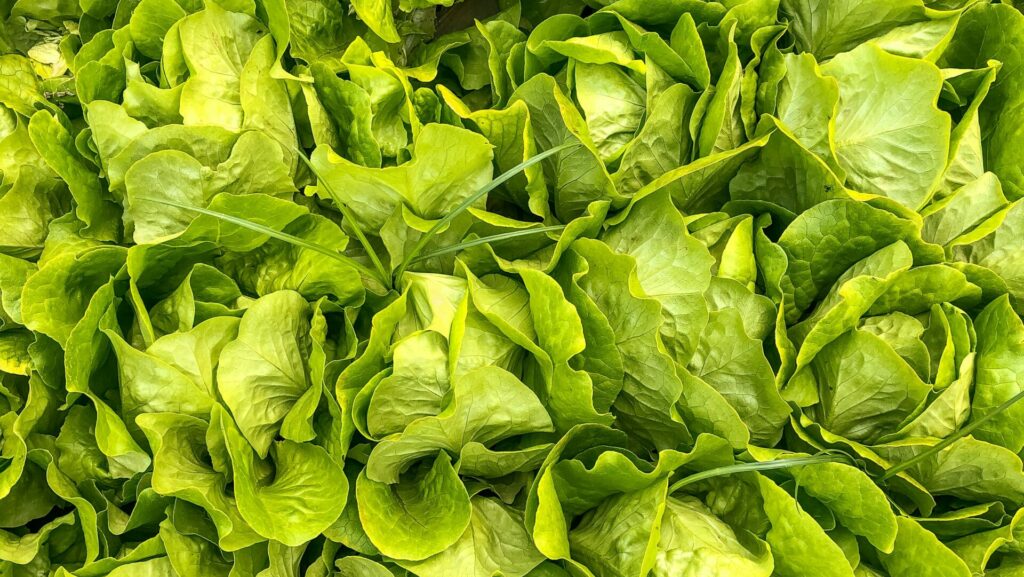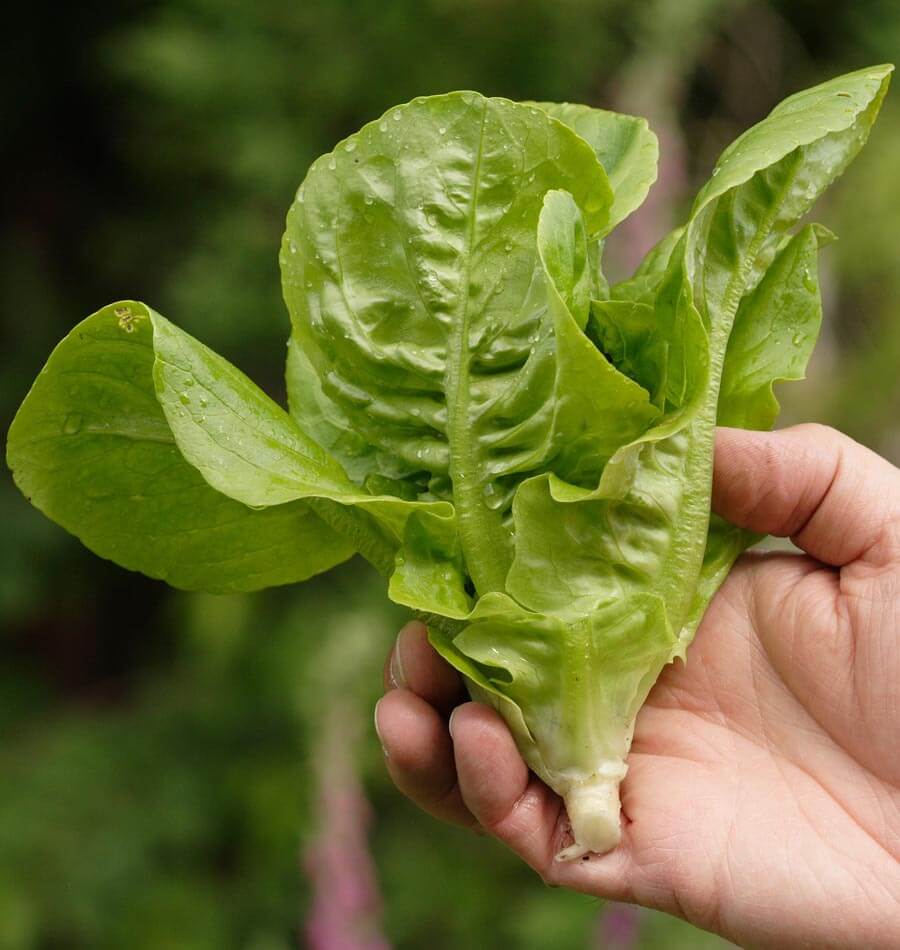
Romaine lettuce is a crop that flourishes in cool weather and well-drained, moist soil. It is recommended to plant it in an area that receives full sun to partial shade. During planting, it is advisable to space the seedlings approximately 12 inches apart. Adequate watering is essential for the growth of Romaine lettuce, particularly during hot and dry weather conditions.
How to Grow Romaine Lettuce – the easy way
Seeding
It’s best to start your seeds indoors in a starter tray with cells.
- Fill each cell with high-quality potting soil.
- Sow 2 or 3 seeds per cell. Place your tray on a windowsill for light.
- Your plants should start to pop up within 5 to 7 days.
- Once your starters are an inch tall, remove the weakest ones in each cell, leaving only the strongest ones behind.
- Harden your seedlings by placing them outside for a few hours each day. Then, plant your seedlings outside roughly 4 to 6 weeks before your local frost date.
- Space the plants 9 to 12 inches apart in the garden.
- Romaine lettuce likes a nitrogen-rich, well-fertilized soil.
Watering & Sunlight
Like other leafy vegetables, romaine lettuce does well in the shade.
- Too much sun will cause the lettuce to bolt, which means that it quickly produces seeds while neglecting the leaves. Using a floating row cover will help protect the lettuce during hot weather and reduce the tendency to bolt.
- Lettuce plants are made mostly of water, so don’t allow the soil to dry out! If the top of your soil is dry, soak the ground well.
Mulching around your lettuce plants will help the soil retain its moisture and also help keep weeds under control.
Harvesting
There are two ways to harvest romaine lettuce, the cut-and-come-again method and one-cut method.
- In the cut-and-come-again method, you cut off the outer leaves starting at the outside of the plant and going in a circle. Leave at least an inch on the bottom of the lettuce stem, known as the crown. Leave the undeveloped leaves in the center, since these will continue growing and will provide you with another harvest later on.
- In the one-cut method, you simply slice off the whole head of lettuce in one cut using a very sharp knife. It’s the most efficient way of harvesting lettuce but you won’t get any more harvests afterward.
- Romaine lettuce is ready to be harvested within 50 to 75 days. If you pick lettuce too late it may have turned bitter or woody!
Varieties
Lettuce comes in two types: loose-leaf lettuces and heading lettuces. Romaine lettuce (also known as cos lettuce) is a heading type of lettuce. However, there are many lettuce varieties of the Romaine type!
- Valmaine: this variety is very heat-tolerant, and it’s also very large!
- Jericho: also very heat-tolerant and resistant to bolting.
- Winter Density: this one is more tolerant to the cold, which is great for northern climates.
- Little Gem: bred as a dwarf variety for growing indoors or in tight spaces.
- Breen: another miniature variety, with bronze-colored oval shaped leaves.
- Truchas: deep red leaves with a green crown.
- Cimmaron: dark red-purple leaves with a green crown.
Pests
- Rabbits: if you have a rabbit problem, you can use a floating row cover that shields the plants while letting sunlight in. You can also use raised beds or hanging baskets.
- Slugs and Snails: the best way to repel slugs and snails is to spread diatomaceous earth on the ground around your lettuce. Don’t use pesticides, since they are readily absorbed by the plants.
How to Grow Lettuce Indoors

Growing romaine lettuce is possible indoors, provided you have adequate lighting and you select a variety that does well in an indoor setting.
- Dwarf varieties as well as ones bred for colder climates typically do well indoors. Some examples are Little Gem and Rouge d’Hiver.
- You’ll need to give your plants at least 8 hours of light per day. If you don’t have a south-facing window, it’s a good idea to invest in a grow light meant for leafing plants.
- Plant nurseries often sell grow-bulbs separately which you can put into a lamp you already have, saving you some money.
- Lettuce roots are small, so your container only needs to be 3 to 4 inches deep.
- Any quality potting soil will do, since lettuce plants aren’t very picky when it comes to dirt.
- Make sure you remember to water your plants often enough to keep the soil moist without waterlogging it.
How to Regrow Lettuce From Scraps
Lettuce can be regrown from lettuce leaves or cuttings bought at the store! It won’t be as large as a plant grown from seed, but it’s free!
- Cut the lettuce off about 2 inches from the bottom of the head, known as the crown.
- Place the bottom of the crown in a container with about half an inch of water at the bottom, no higher!
- Place your container in a windowsill where it will get at least a few hours of sunlight per day.
- It’s a good idea to change the water every 1 to 2 days so that your crowns won’t get soggy.
- After 10 to 12 days, your lettuce crown should have rootlets and some leaves on it. It’s best to move the plant into soil at this point since it will grow much better than in water.
Frequently Asked Questions
When you transplant your seedlings into your garden, place them 9 to 12 inches apart. Rows should be 12 to 18 inches apart.
How do I harvest lettuce without killing the plant?
Use the cut-and-come-again method. This means that you cut the oldest leaves around the outside of the plant, going in a circle, leaving the young, undeveloped leaves in the middle of the plant. These young leaves will finish developing later, allowing you to harvest your lettuce multiple times. Be sure to leave at least an inch at the bottom of the plant, known as the crown.
What are good companion plants for lettuce?
Tall plants like tomatoes and sunflowers will shield your lettuce from the hot sun. Strong-scented herbs like basil and oregano will repel many insects. Other good companion plants include carrots, dill, spinach, squash, strawberries, broccoli, and cauliflower.
When do I plant lettuce in central Florida?
The best period to plant lettuce in central Florida is from September to March. This period is the cooler part of the year which is ideal for growing lettuce since it tends to bolt when subjected to full summer heat.
